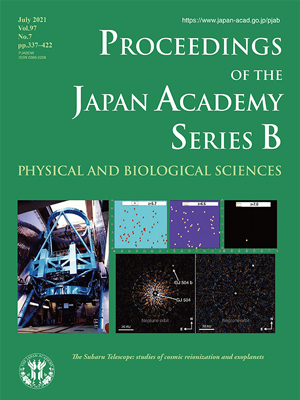About the Cover
Vol. 97 No. 7 (2021)
The Subaru Telescope: studies of cosmic reionization and exoplanets
Observational research of stars and galaxies by Japanese astronomers began with the completion of the 188 cm telescope at the Okayama Astrophysical Observatory in 1960, and the 105 cm Schmidt telescope at the Kiso Observatory in 1974. The Japanese astronomical community then initiated a bold step forward to construct a 8.2 m telescope, the Subaru Telescope, atop the summit of Maunakea on the Big Island of Hawaii. This is widely regarded as the best astronomical site in the northern hemisphere.
An innovative aspect of the Subaru Telescope (cover figure, left) is its use of “active optics” to precisely control the optimal shape of the primary mirror surface using 261 computer-controlled actuators working at a frequency of 1 Hz. This was followed by the installation of an “adaptive optics” system behind the Nasmyth focus which compensates at a faster frequency of 1 kHz for the optical wavefront distortion caused by the turbulent atmosphere. Using adaptive optics enabled a diffraction-limited performance improving the image quality of the Subaru telescope by a factor of ten as discussed in the review article by Dr. Masanori Iye within this volume (pp.337–370).
Dr. Iye’s review also discusses a selection of scientific discoveries made by the Subaru Telescope and its unique instrumentation. The upper right three panels of the cover figure show the sky distribution of “Lyman alpha emitting” galaxies, intensely star-forming systems, at three epochs of cosmic time: redshifts 5.7, 6.6, and 7.0, which correspond to “look-back times” of 12.80, 12.97, and 13.03 billion years ago, respectively. The abrupt increase of detectable galaxies between 13.03 and 12.97 billion years ago indicates that intergalactic neutral hydrogen was mostly reionized during that interval, thereby increasing the visibility of the Lyman alpha photons. These pioneering Subaru observations were key in demonstrating when this “cosmic reionization” process ended.
The lower right panels of the cover figure show high resolution images of a solar-type star, GJ504, observed with a coronagraphic camera, HiCIAO, behind the adaptive optics system. The coronagraphic mask obstructs the bright diffraction-limited stellar image at the center of the left panel, thus revealing an orbiting planet GJ504b at the upper right corner of the right panel.
Richard Ellis
Professor of Astrophysics, University College London




